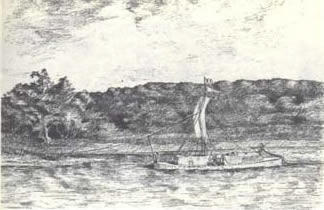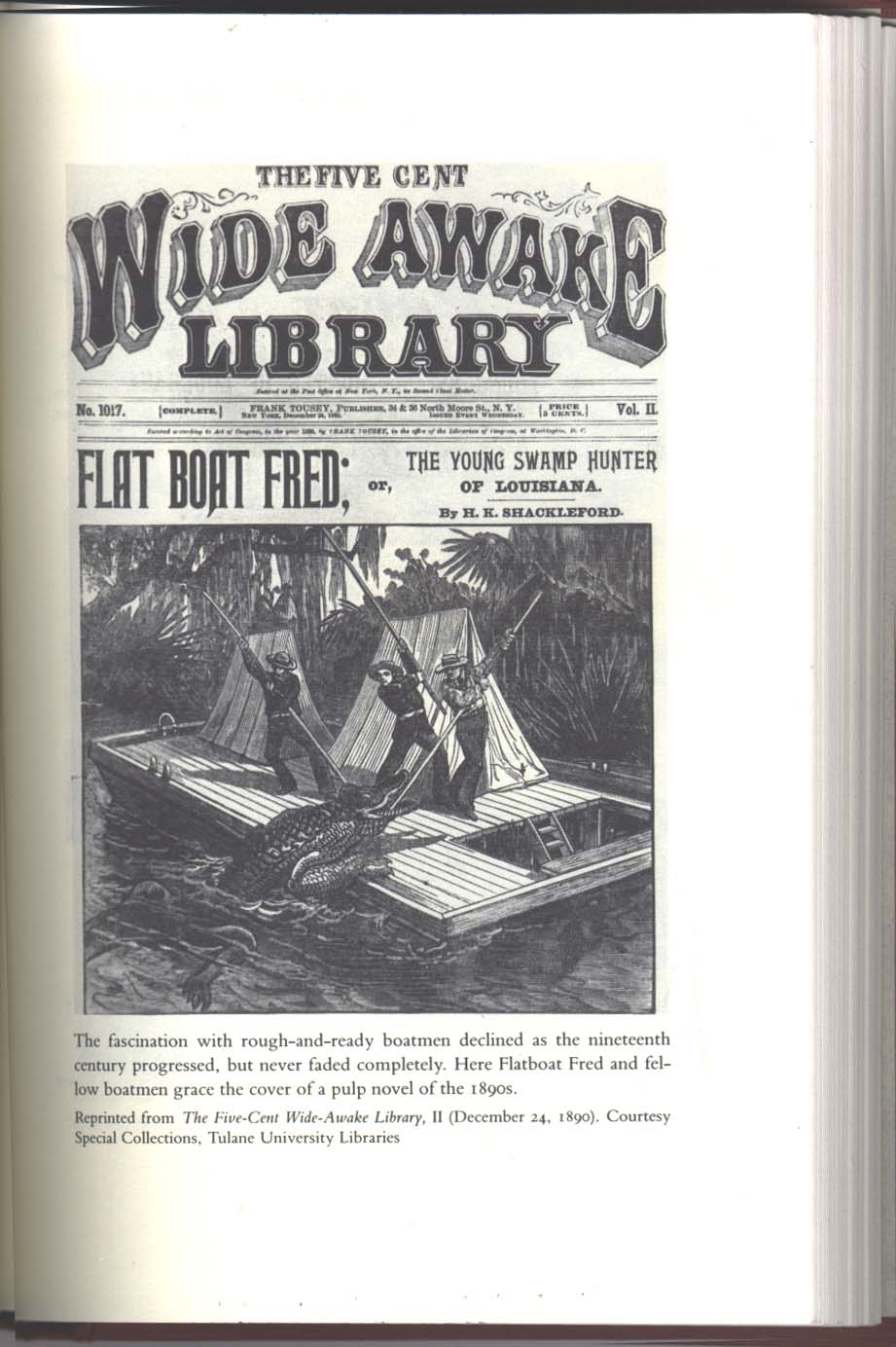The lives of non-steam western rivermen were
ones of bravery, accomplishments, and discoveries. Flatboatmen,
keelboatmen, and raftsmen who braved the Ohio
River led dangerous
and lonely lives, but uncovered beautiful parts of the country
on their journeys down the river and into the smaller streams.
Most of the rivermen were illiterate, leaving little written
documentation of their findings. The few documents that the
rugged boatmen did leave behind help in uncovering the land
of Indiana as they discovered and experienced it.

Keelboat on
the Ohio River
|
Zadok Cramer, author of The
Navigator,
recorded these discoveries. He documented what the landscape
of Indiana surrounding the Ohio River was like for the boatmen.
In a time of westward expansion, Cramer's The Navigator
helped many common people learn about the river, as well as
where and what to look for when purchasing a boat. The
Navigator was published in 1801 and in less than twenty-five
years went through twelve editions.
Sold for a dollar a copy, Cramer's book helped
people navigate their way down the Ohio River in search of
their new homes. Descriptions of characteristics of the river
and towns were subjects of The Navigator. He took
you through towns, describing the scene and what to watch
for while going down the river. While traveling through Jeffersonville,
Indiana, the common person could pull out his copy of The
Navigator and read:
In point of natural advantages and beauty,
there are few or no situations on the Ohio more eligible
for a town. The bank is very high, and surrounded with
a
rich, level and fertile country. The current and channel
of the Ohio for several miles above, are on the N.W. shore,
and the depth of the water being sufficiently great at
any season of the year for boats or vessels of any burden,
afford
at all times an easy landing place, and good harbor for
boats descending the Ohio. In descending the Ohio, the
first
place of landing is at Bloom's Eddy; - this eddy is just
below the first and greatest obstacle in the rapids -
it
is a large and convenient landing place for boats at a
low stage of the water, and from which, flat boats may
pass
the balance of the falls with their loading at a low stage
of the water. It is thought it will become the principal
landing place for boats having to unload above the falls
(122-123).

Advertisement
for adventures of the rivermen |
Jeffersonville was an important landing place
for people traveling the Ohio River, because it was one
of only a few towns where people could stop before taking
on the Great Falls. Michael Allen, contemporary author and
admirer of the lifestyles of the river boatmen wrote in
his book, Western
Rivermen, 1763-1861, that "an
oblique limestone ridge crossing the Ohio River created
the Great Falls, the worst single navigation hazard on the
western waters" (38).
Many contemporary authors admire and enjoy Cramer's
work, as well as the adventures of the boatmen. One such author
is Allen. From Cramer's work as well as other documents, Allen
was able to describe the scene the early boatmen saw of the
Ohio River as "a humid, lush, green world inhabited by
a myriad of wild animals, fish, fowl, and insects" (27).
The works of both Cramer and Allen make it obvious
why the French originally called the Ohio River "La Belle
Riviere," which means the beautiful river. As boatmen
made the journey through the Lower Ohio, Allen found that
they documented catfish, perch, doves, redheaded woodpeckers,
and nighthawks. They also passed under poplars, beech trees,
hickories, walnuts, oaks, grapevines, red maples, willows,
and cottonwoods. This vegetation made up the lush forests that surrounded the river.

Rivermen on
a flatboat |
The rivermen and common men who braved the journey
down the Ohio River experienced beautiful and scenic landscapes
as well as the familiar harsh waters of the Ohio. Authors
like Cramer who's guide The Navigator helps us know
today what the Ohio River experience was like for the unknowing
traveler two hundred years ago. He showed them the way and
told them what to look for in way of danger and unforgettable
landscapes. In documenting these facts, Cramer was unknowingly
capturing the landscapes of the river and its beautiful landmarks
for years and generations to come.
--KLP
Sources: Allen,
Michael. Western Rivermen, 1763-1861.
Louisiana State University Press.
Baton Rouge: 1990.
Cramer, Zadok. The Navigator.
University Microfilms, Inc. Ann Arbor:
1966.
Links: Cramer biography
Description of The Navigator
|




